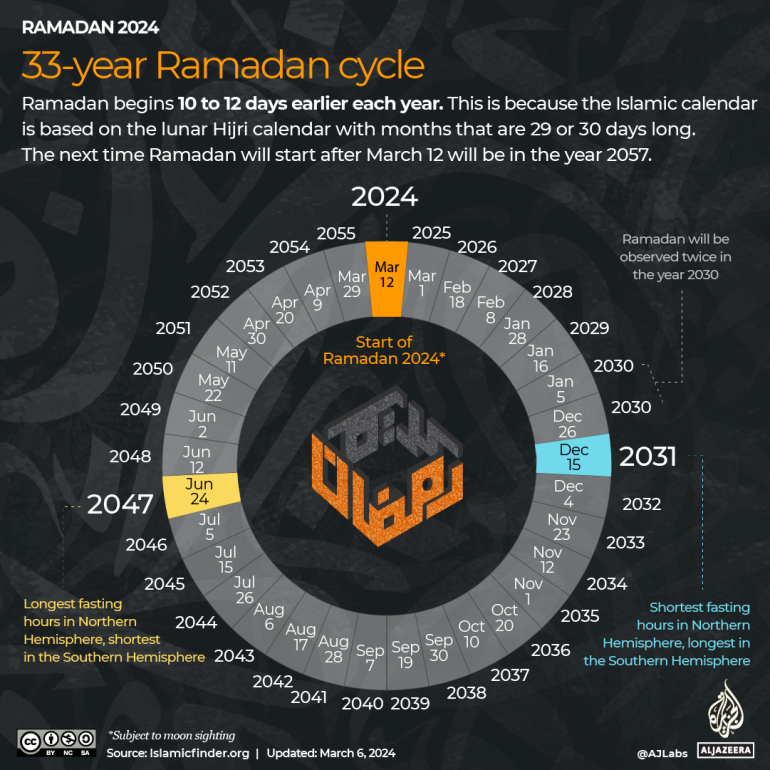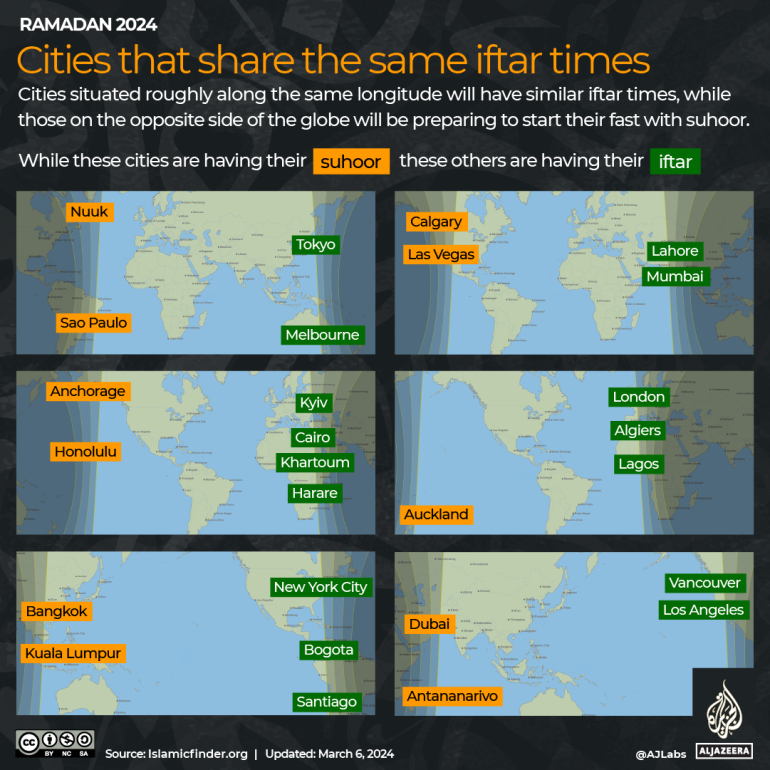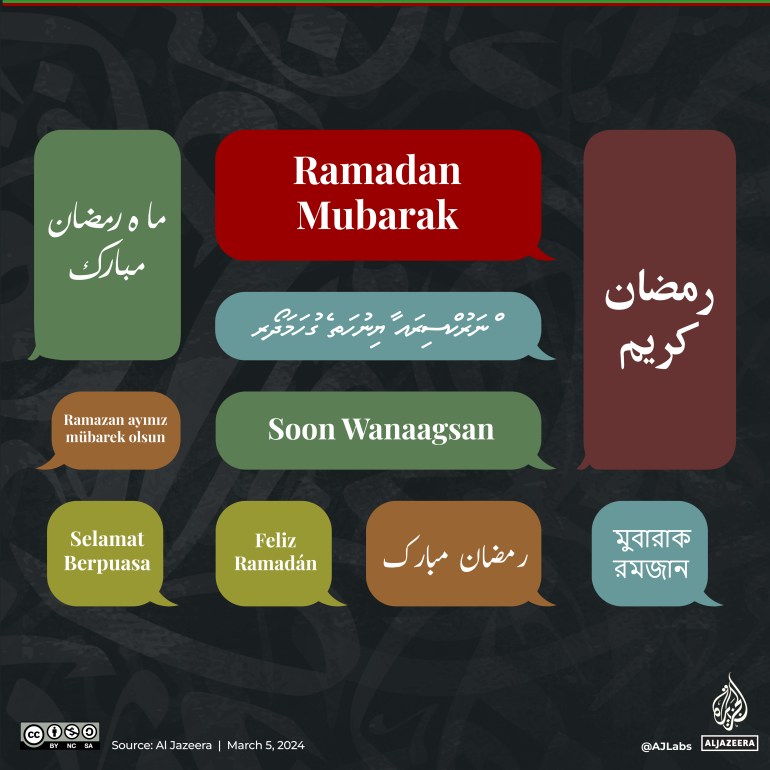Ramadan 2024: Fasting hours and iftar times around the world
Why does Ramadan start on different dates every year?
Ramadan begins 10 to 12 days earlier each year. This is because the Islamic calendar is based on the lunar Hijri calendar with months that are 29 or 30 days long. Because the lunar year is shorter than the solar year by 11 days, Ramadan will be observed twice in the year 2030 – first beginning on January 5 and then starting on December 26. The next time Ramadan will start after March 12 will be 33 years from now – in the year 2057.
Fasting hours around the world
The number of daylight hours varies across the world. Muslims living in the world’s southernmost countries, such as Chile or New Zealand, will fast for about 12 hours, while those living in northernmost countries, such as Iceland or Greenland, will have 17-plus hours fasts. For Muslims living in the Northern Hemisphere, the number of fasting hours will be a bit shorter this year and will continue to decrease until 2031, which is the year Ramadan will encompass the winter solstice – the shortest day of the year. After that, fasting hours will increase until the summer solstice – the longest day of the year in the Northern Hemisphere. For fasting Muslims living south of the equator, the opposite will happen. In extreme northernmost cities, such as Longyearbyen in Norway, where the sun does not set from April 20 to August 22, religious rulings have been issued to follow timings in Mecca, Saudi Arabia, or the nearest Muslim country.
Cities that share the same iftar times
The predawn meal to start the daily fast is called suhoor, while the breaking of one’s fast after sunset is called iftar. Cities situated roughly along the same longitude will have similar iftar times, while those on the opposite side of the globe will be preparing to start their fast with suhoor. The infographic below shows which cities are having suhoor while others are having their iftar.
Fasting times around the world
The table below shows the suhoor and iftar times on the first and last days of Ramadan 2024. Use the arrows or search box to find your city.Which cities have the longest and shortest fasting hours?
Below are the average number of fasting hours in cities around the world. Actual fasting hours and times will vary by day, as well as calculation methods: – Nuuk, Greenland: 16 hours – Reykjavik, Iceland: 16 hours – Helsinki, Finland: 15 hours – Oslo, Norway: 15 hours – Glasgow, Scotland: 15 hours – Berlin, Germany: 15 hours – Dublin, Ireland: 15 hours – Moscow, Russia: 15 hours – Amsterdam, the Netherlands: 15 hours – Warsaw, Poland: 15 hours – Astana, Kazakhstan: 15 hours – Brussels, Belgium: 14 hours
– London, UK: 14 hours
– Zurich, Switzerland: 14 hours
– Stockholm, Sweden: 14 hours
– Bucharest, Romania: 14 hours
– Sarajevo, Bosnia and Herzegovina: 14 hours
– Sofia, Bulgaria: 14 hours
– Rome, Italy: 14 hours
– Madrid, Spain: 14 hours
– Paris, France: 14 hours
– Lisbon, Portugal: 14 hours
– Ankara, Turkey: 14 hours
– Ottawa, Canada: 14 hours
– Tokyo, Japan: 14 hours
– Beijing, China: 14 hours
– Athens, Greece: 14 hours
– New York City, US: 14 hours
– Washington, DC, US: 14 hours
– Los Angeles, US: 14 hours
– Tunis, Tunisia: 14 hours
– Algiers, Algeria: 14 hours
– Tehran, Iran: 14 hours
– Kabul, Afghanistan: 14 hours
– New Delhi, India: 14 hours
– Dhaka, Bangladesh: 14 hours
– Rabat, Morocco: 14 hours
– Damascus, Syria: 14 hours
– Islamabad, Pakistan: 14 hours
– Baghdad, Iraq: 14 hours
– Beirut, Lebanon: 14 hours
– Amman, Jordan: 14 hours
– Gaza City, Palestine: 14 hours
– Cairo, Egypt: 14 hours
– Doha, Qatar: 13 hours
– Dubai, UAE: 13 hours
– Khartoum, Sudan: 13 hours
– Riyadh, Saudi Arabia: 13 hours
– Abuja, Nigeria: 13 hours
– Aden, Yemen: 13 hours
– Dakar, Senegal: 13 hours
– Addis Ababa, Ethiopia: 13 hours
– Buenos Aires, Argentina: 13 hours
– Colombo, Sri Lanka: 13 hours
– Kuala Lumpur, Malaysia: 13 hours
– Mogadishu, Somalia: 13 hours
– Ciudad del Este, Paraguay: 13 hours
– Nairobi, Kenya: 13 hours
– Brussels, Belgium: 14 hours
– London, UK: 14 hours
– Zurich, Switzerland: 14 hours
– Stockholm, Sweden: 14 hours
– Bucharest, Romania: 14 hours
– Sarajevo, Bosnia and Herzegovina: 14 hours
– Sofia, Bulgaria: 14 hours
– Rome, Italy: 14 hours
– Madrid, Spain: 14 hours
– Paris, France: 14 hours
– Lisbon, Portugal: 14 hours
– Ankara, Turkey: 14 hours
– Ottawa, Canada: 14 hours
– Tokyo, Japan: 14 hours
– Beijing, China: 14 hours
– Athens, Greece: 14 hours
– New York City, US: 14 hours
– Washington, DC, US: 14 hours
– Los Angeles, US: 14 hours
– Tunis, Tunisia: 14 hours
– Algiers, Algeria: 14 hours
– Tehran, Iran: 14 hours
– Kabul, Afghanistan: 14 hours
– New Delhi, India: 14 hours
– Dhaka, Bangladesh: 14 hours
– Rabat, Morocco: 14 hours
– Damascus, Syria: 14 hours
– Islamabad, Pakistan: 14 hours
– Baghdad, Iraq: 14 hours
– Beirut, Lebanon: 14 hours
– Amman, Jordan: 14 hours
– Gaza City, Palestine: 14 hours
– Cairo, Egypt: 14 hours
– Doha, Qatar: 13 hours
– Dubai, UAE: 13 hours
– Khartoum, Sudan: 13 hours
– Riyadh, Saudi Arabia: 13 hours
– Abuja, Nigeria: 13 hours
– Aden, Yemen: 13 hours
– Dakar, Senegal: 13 hours
– Addis Ababa, Ethiopia: 13 hours
– Buenos Aires, Argentina: 13 hours
– Colombo, Sri Lanka: 13 hours
– Kuala Lumpur, Malaysia: 13 hours
– Mogadishu, Somalia: 13 hours
– Ciudad del Este, Paraguay: 13 hours
– Nairobi, Kenya: 13 hours
 – Harare, Zimbabwe: 13 hours
– Jakarta, Indonesia: 13 hours
– Luanda, Angola: 13 hours
– Bangkok, Thailand: 13 hours
– Brasilia, Brazil: 13 hours
– Johannesburg, South Africa: 13 hours
– Montevideo, Uruguay: 13 hours
– Canberra, Australia: 13 hours
– Puerto Montt, Chile: 13 hours
– Christchurch, New Zealand: 13 hours
– Harare, Zimbabwe: 13 hours
– Jakarta, Indonesia: 13 hours
– Luanda, Angola: 13 hours
– Bangkok, Thailand: 13 hours
– Brasilia, Brazil: 13 hours
– Johannesburg, South Africa: 13 hours
– Montevideo, Uruguay: 13 hours
– Canberra, Australia: 13 hours
– Puerto Montt, Chile: 13 hours
– Christchurch, New Zealand: 13 hours
Ramadan greetings in different languages
Various Muslim-majority nations have a personalised greeting in their native languages. “Ramadan Mubarak” and “Ramadan Kareem” are the most common greetings exchanged in this period, wishing the recipient a blessed and generous month, respectively.
